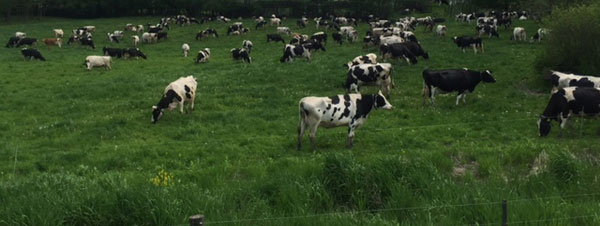How to Restore Their Perceived Value
By Cheryl Cesario, UVM Grazing Specialist

A recent study published in the scientific journal, ‘Nature’, examined the importance of species diversity in grassland ecosystems. The German-based study included dozens of researchers collecting data along various levels of the grassland food chain. The data was collected on a total of 4600 species, the most extensive ecological sampling in Europe to date. These species, they found, interact and rely on each other to provide critical grassland ‘ecosystem services’, such as food production, soil development, carbon storage, and flood and drought mitigation, among other climate regulatory functions. The study emphasizes the importance of maintaining biodiversity across all levels of the grassland food chain, which provide synergistic effects that ultimately benefit the planet and humanity as a whole.
So if grasslands play such a critical role in our planet’s health, why are they disappearing at an alarming rate? The same month the ‘Nature’ study was published, the Union of Concerned Scientists published an article about the continued reduction of grassland acres across the U.S. From 2008-2012, extensive acreage was cultivated for the first time, mostly planted to annual crops. This phenomenon was greatest in the Great Plains and western Corn Belt, where 77% of new cropland was borne from grasslands. Several crops took their place, led by corn, wheat and soybeans. These grasslands are being traded for crops that require irrigation in areas where irrigation and drinking water supplies are shrinking.
Contrast this with the ‘Nature’ study regarding the importance of grassland biodiversity and the role these ecosystems play in climate adaptation. The regions of the country with the highest loss of grasslands are also the same ones where flooding frequency has increased the most. This doesn’t seem like the best strategy for building resiliency.
There are USDA programs designed to encourage and protect grasslands, such as the Conservation Reserve Program (CRP). CRP encourages farmers to convert highly erodible cropland or other environmentally sensitive acreage to vegetative cover, such as native grasses, wildlife plantings, filter strips, or riparian buffers. Farmers receive an annual rental payment for the term of the multi-year contract. However, enrollment peaked at 36.8 million acres in 2007, dropping to 24.2 million acres by September 2015. States such as Kansas, North Dakota, Montana and Texas have seen reductions of over 1 million acres each in CRP land over the past 8 years. For scale comparison, in Vermont our CRP acres total approximately 2,800 acres, mostly in various riparian buffer, filter strip, and habitat plantings. While we don’t have large swaths of native grasslands here in Vermont, we do import large amounts of grain from the Midwest to feed cattle and other livestock, so ultimately we are part of the grassland-biodiversity-climate adaptation issue.
When commodity prices are high, acres that transition out of the program are often not re-enrolled. The trend may continue: between 2020 and 2022, 11.6 million CRP acres are scheduled to expire nationwide and it remains to be seen what the future holds for those grassland acres. With more and more discussion and interest in adaptive, resilient and regenerative agriculture, one would hope that more policies and programs may be on the horizon to encourage biodiverse grassland ecosystems that provide so many benefits.
To read more:
Do you have questions about grazing management? Contact Cheryl Cesario [802-388-4969 ext. 346 or cheryl.cesario@uvm.edu]














